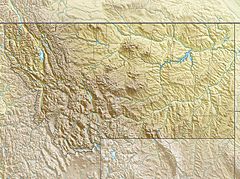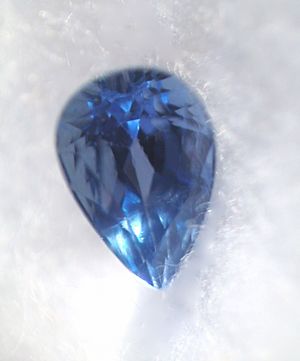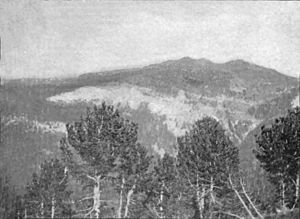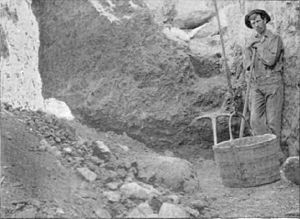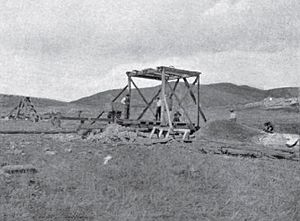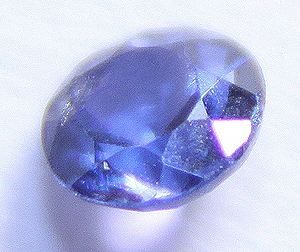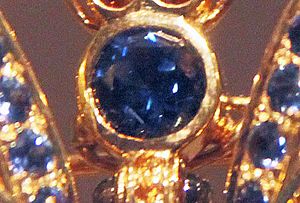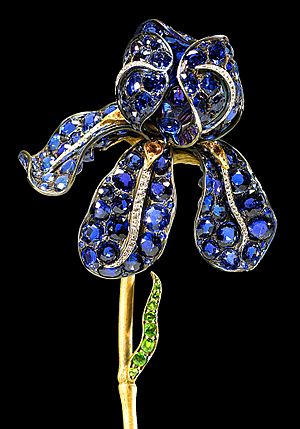Yogo sapphire facts for kids
Quick facts for kids Yogo sapphire |
|
|---|---|

A 0.65-carat (0.130 g) cornflower blue Yogo sapphire
|
|
| General | |
| Category | Oxide mineral |
| Formula (repeating unit) |
Aluminium oxide, Al2O3 |
| Crystal symmetry | R3c |
| Identification | |
| Color | Cornflower blue to purple |
| Crystal habit | Hexagonal, rhombohedral, prismatic or dipyramidal |
| Crystal system | Trigonal |
| Twinning | Lamellar |
| Cleavage | Partings on {0001} and {1011} |
| Fracture | Uneven to conchoidal |
| Tenacity | Brittle |
| Mohs scale hardness | 9.0 |
| Luster | Adamantine to vitreous |
| Specific gravity | 3.98–4.10 |
| Optical properties | Uniaxial (–) Abbe number 72.2 |
| Refractive index | nω=1.767–1.772 nε=1.759–1.763, Birefringence 0.008 |
| Pleochroism | Weak |
| 2V angle | 58° |
Yogo sapphires are beautiful blue gemstones found in Montana, USA. They are a special type of corundum, which is one of the hardest minerals on Earth. What makes Yogo sapphires unique is their lovely cornflower blue color. This color comes from tiny amounts of iron and titanium inside the gem.
Unlike many other sapphires, Yogos are usually very clear and bright. They keep their sparkle even under artificial lights. Most sapphires around the world are heated to make their color better, but Yogo sapphires naturally have a deep, even color. This means they don't need any special heat treatment.
Yogo sapphires are found in a long, thin rock formation called a dike in Yogo Gulch. Mining them has been tricky and not always profitable. Experts believe there are still at least 28 million carats (about 5.6 tons) of Yogo sapphires hidden in the ground. These special gems have been given to important people, like First Ladies of the United States. Today, you can even see some Yogo sapphires in the Smithsonian Institution's gem collection.
Yogo sapphires were not always recognized for their value. Gold was discovered in Yogo Creek in 1866. Miners noticed "blue pebbles" mixed with the gold, but they didn't know what they were. It wasn't until 1894 that these "blue pebbles" were identified as sapphires. Sapphire mining officially began in 1895. A local rancher named Jake Hoover sent some gems he had collected to an expert. The expert at Tiffany & Co. in New York called them "the finest precious gemstones ever found in the United States." This led to the start of the "English Mine," which was very successful from 1899 to the 1920s.
The name "Yogo sapphire" is used only for gems found in Yogo Gulch. Sapphires found in other parts of Montana are called "Montana sapphires." Montana produces more high-quality sapphires than any other place in North America. In 1969, the sapphire became one of Montana's official state gemstones.
In the 1980s, a company called Intergem Limited started selling Yogo sapphires as the only "untreated" sapphires in the world. This was a big deal because most other sapphires were being heat-treated. Even though Intergem later closed, many of its sapphires were still sold in the 1990s. Today, most of the big mines are not active. Some people still mine for fun as a hobby.
Contents
Where to Find Yogo Sapphires
Yogo sapphires are found in a place called Yogo Gulch in Montana. This area is in Judith Basin County, Montana. It's about 12 miles (19 km) southwest of Utica. When the sapphires were first found, this area was part of Fergus County. But county lines were changed in 1920, and Judith Basin County was created.
Yogo Gulch, Yogo Peak, Yogo Creek, and the Yogo dike are all in the Little Belt Mountains. The Yogo dike is where the gems are mined. It's a long, narrow rock formation. Jake Hoover, who helped discover the sapphires, had a ranch nearby.
What Does "Yogo" Mean?
Yogo Gulch is in a region where the Piegan Blackfeet people used to live. Some people say that "yogo" might mean "romance" or "blue sky" in the Blackfoot language. However, there isn't much proof for this idea. The true meaning of the word "Yogo" was lost by 1878, when gold was found in Yogo Creek. So, no one is really sure what it means.
How Yogo Sapphires Form
Sapphires are a type of corundum. Corundum is a very hard mineral, rating 9 on the Mohs scale of mineral hardness. This means it's almost as hard as a diamond (which is a 10). Most corundum gems are called sapphires, except for red ones, which are called rubies.
Yogo sapphires are special because they are usually free of flaws or tiny bits inside them. They have a clear, even color and don't need heat treatment. They also keep their sparkle in artificial light, unlike some other sapphires. Yogo sapphires are found in solid rock, not in riverbeds like most other sapphires. This makes them easier to cut because they often have a perfect crystal shape. They also have a unique triangular pattern on their flat surfaces.
Yogo sapphires are known for being beautiful, small, and quite expensive. Experts say they are "among the world's finest sapphires." It's rare to find a cut Yogo gem heavier than 2 carats. Only about 10 percent of cut Yogos are over 1 carat. The largest Yogo ever found was 19 carats, which was cut into an 8-carat gem. The largest cut Yogo is 10.2 carats. Because large Yogo sapphires are so rare, their prices go up a lot for gems over 0.5 carats, and even more for those over 1 carat.
Most Yogo sapphires are blue. About two percent are purple, due to tiny amounts of chromium. Very few rubies have been found in Yogo Gulch.
The Yogo dike, where the sapphires are found, is a dark gray to green intrusive rock called a lamprophyre. This rock formed from magma deep underground. Scientists have studied the crystals in the rock to figure out its age (about 48.6 million years old) and how hot it was when it formed (around 900 °C).
The sapphires themselves might have come from an even older rock that was later picked up by the lamprophyre magma. This means the sapphires were not formed at the same time as the dike rock. This is why they have their special qualities.
The Yogo dike is a narrow, almost vertical sheet of rock. It's between 2 and 26 feet (0.6 to 7.9 meters) thick and stretches for about 5 miles (8 km). It formed when magma pushed into cracks in older limestone and other sedimentary rocks.
Scientists have studied the Yogo dike to understand how deep it goes and how many sapphires it contains. One expert, Delmer L. Brown, found that the dike is at least 7,000 feet (2,100 meters) deep. He also learned that the sapphires are not spread evenly throughout the dike. Yogo sapphires formed under very high temperatures and pressures over long periods. This is why they have such perfect color and few flaws.
Montana Sapphires
"Yogo sapphire" refers only to gems from Yogo Gulch. "Montana sapphire" is a broader term for gems found elsewhere in Montana. Montana produces more gem-quality sapphires than any other place in North America. Montana sapphires come in many colors, though rubies are rare.
The first sapphires in the United States were found in Montana on May 5, 1865, near Helena. These early sapphires were not very good quality, which gave Montana sapphires a bad reputation at first. More sapphires were found in other Montana locations in the late 1800s.
Sapphires from these other sites are often heat-treated to make their color better. The Rock Creek area, also known as Gem Mountain, is the most productive sapphire site in Montana. It has produced over 190 million carats of sapphires since 1906. Other Montana sapphire mines have been less successful because they don't have many blue sapphires, and other colors are less profitable.
The mountains near Rock Creek are even named the Sapphire Mountains because of the gems found there. In 1969, the sapphire and agate were both named Montana's official state gemstones.
History of Yogo Sapphire Mining
Mining Yogo sapphires has always been very difficult. Even so, the sapphires turned out to be more valuable than many gold discoveries in the area.
The Yogo Gulch area was originally home to the Piegan Blackfeet people. Gold was first found in Yogo Creek in 1866. Early gold miners faced challenges from local Native Americans. In 1878, about a thousand miners came to Yogo Creek during a gold rush. They found "blue pebbles" along with small amounts of gold. The mining camp, Yogo City, only lasted about three years before most people left.
Yogo City was briefly called Hoover City, after Jake Hoover. He is known for discovering Yogo sapphires. Jake Hoover later explored for gold in Alaska and became a fishing guide in Seattle. He eventually returned to Montana. The famous Western painter C.M. Russell worked for Hoover as a young cowhand in 1880. Russell said he learned many of his frontier skills from Hoover, and they remained friends for life.
Millie Ringold, a former slave, also lived in Yogo City. She opened a hotel, restaurant, and saloon there. She also worked her own gold claims. Millie was known as a great cook and was the last person living in Yogo City when she died in 1906. The nearby town of Utica is shown in Russell's 1907 painting, A Quiet Day In Utica. Jake Hoover, Millie Ringold, and Russell himself are all in the painting.
How Yogo Sapphires Were Discovered
In 1894, the "blue pebbles" were finally identified as sapphires. One story says a local school teacher recognized them. Another story says a miner named S.S. Hobson thought they might be sapphires, and a jeweler confirmed it.
In 1895, Jake Hoover sent a box of the blue stones he had collected to an assay office. They sent them to Tiffany & Co. in New York City. Dr. George Frederick Kunz, a leading gem expert, was very impressed. He called them "the finest precious gemstones ever found in the United States." Tiffany's sent Hoover a check for $3,750. They also sent a letter calling the stones "sapphires of unusual quality."
Early Mining Efforts
The source of the Yogo sapphires was eventually found. In February 1896, a sheepherder named Jim Ettien discovered the main sapphire deposit, the Yogo dike. He found sapphires in a crack in a limestone rock. Ettien claimed two mining spots. The sapphire vein was 5 miles (8 km) long, and other miners quickly claimed spots along it. Ettien sold his claims to Hoover, who then sold his share to partners for $5,000. This site became known as the "New Mine Sapphire Syndicate."
In 1899, a company from London, England, bought the New Mine Sapphire Syndicate for $100,000. This operation became known as the "English Mine."
On July 4, 1896, two Americans, John Burke and Pat Sweeney, claimed six mining spots on the western part of the Yogo dike. These claims became known as the "American Mine." It was later bought by the American Gem Syndicate and then the American Sapphire Company.
An Englishman named Charles Gadsden became the supervisor of the English Mine in 1902. He focused on sapphires instead of gold. Gadsden had very strict security because rough sapphires were worth much more than gold. The English Mine did very well until the 1920s. However, floods in 1923 badly damaged the mines, and they never fully recovered. The English Mine finally closed in 1929. It had produced over 16 million carats of rough sapphires. These produced 2.5 million carats of finished gems, worth $25 million in 1929. Other companies tried to mine there but had little success. Gadsden continued to care for the mines until he died in 1954.
The American Mine was not as profitable as the English Mine. The English Mine had better mining methods and a richer sapphire vein. The American Mine had problems with space and water. The English Mine shipped its rough sapphires to London and sold them in Europe. The American Mine struggled to sell its gems in the United States. The American Sapphire Company went out of business in 1909. A new company, the Yogo American Sapphire Company, bought the mine but also went bankrupt by 1913. The English syndicate then bought the American Mine in 1914, gaining control of all known Yogo deposits.
Mining from the 1940s to 1970s
During World War II, Montana sapphires were mined a lot for industrial uses, like abrasives. But because the Yogo mines were owned by the English, the U.S. government couldn't control them much. So, the war didn't affect them as much.
After the war, the Yogo Sapphire Mining Corporation tried to run the English Mine. They bought it in 1956. They changed their name to New Mine Sapphire Syndicate, like the old English company. But production was poor, and mining stopped in 1959. From 1959 to 1963, the mine was left open. People came from all over to collect loose sapphires. The company put up fences in 1963 to stop this.
The mine was leased to several operators. One company, Siskon, Inc., lost a lot of money and sued. They bought the mine in 1965 and leased it to Arnold Baron. Baron was good at cutting gems and selling jewelry. He had success selling Yogos in America, which hadn't happened in 50 years. But mining the hard rock was too difficult, so he didn't buy the mine. Siskon sold it in 1968 to Herman Yaras.
In 1969, Yaras's company created Sapphire Village, a nearby housing development. Buyers could mine their own sapphires with hand tools. Yaras's company sold to Chikara Kunisaki in 1973. Kunisaki tried to start a commercial mining operation. He built a modern 3,000-foot (910 m) tunnel, but the costs were too high. His company closed in 1976. This was the last big attempt to mine the American Mine section.
In 1977, Victor di Suvero became the next owner. He was good at marketing gems. He had new ideas for selling Yogos, but he didn't know much about mining. His company failed in 1979.
By 1980, most American-owned Yogo mining efforts had failed. The English company had been the most profitable, but even that didn't last long. American owners often struggled with funding and marketing the gems.
The 1980s and Today
Kunisaki put his mine up for sale for $6 million. In 1981, Harry C. Bullock and J. R. Edington formed a company called American Yogo Sapphire Limited. They bought the mine for $6 million and raised another $7.2 million. Bullock planned to do everything: mining, cutting, making jewelry, and marketing. They sent rough gems to cutters in Thailand, Germany, and Hong Kong. They also got a $5 million loan from Citibank.
In 1982, American Yogo Sapphire Limited changed its name to Intergem Limited. They marketed Yogo sapphires as the "Royal American Sapphire." Their jewelry was sold across the U.S. Intergem had good sales in its first four years.
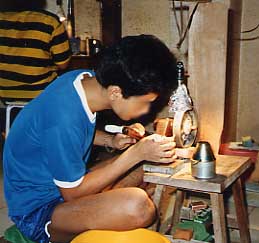
Intergem made a big splash in the gem world by saying Yogo sapphires were the only guaranteed untreated sapphires. At that time, 95 percent of all sapphires were heat-treated to make their color better. Intergem's marketing caused many gem experts to visit Yogo Gulch.
Intergem planned to dig even deeper into the Yogo dike. However, they missed a payment to Kunisaki's company in 1985. Citibank also demanded their loan back because the value of Intergem's gems (their collateral) was going down. Intergem had many sales planned but couldn't make the jewelry because they didn't have enough money. In 1986, Kunisaki's company got the mine back.
Meanwhile, in 1984, two local couples, Lanny and Joy Perry and Chuck and Marie Ridgeway, found a new mining spot at Yogo Gulch. They started mining and called it the "Vortex Mine." This mine was successful for years but closed in 2004.
In 1992, Kunisaki's company found an 11-carat rough sapphire. Another company, AMAX Exploration, leased the mine in 1993. They had some success but decided not to continue because of the high cost of underground mining. During this time, more dikes were found in the area.
In 1995, Intergem's sapphires started appearing on the market again. The company had paid its salespeople in sapphires when it was closing down. Citibank also had a large stock of Yogos, worth about $3.5 million. In 1994, a Montana jeweler named Jim Adair bought Citibank's collection. Adair and a gem expert designed special ways to cut Yogos.
A new owner, Michael Duane Roberts, bought the Vortex Mine in 2008. He planned to use environmentally friendly mining methods. Sadly, Roberts died in a mining accident in 2012. As of 2011, some individual hobby miners still work on small areas at Sapphire Village. However, the main mines are not active.
Famous Yogo Sapphires
Several Yogo sapphires are kept at the Smithsonian Institution in Washington, D.C. The museum received its first Yogo sapphires in 1899. The record-setting 10.2-carat cut Yogo sapphire is also at the Smithsonian.
In 2006, a gemologist named Robert Kane donated 333 Montana sapphires to the Smithsonian. He also gave gold to create a piece of jewelry. A jewelry designer named Paula Crevoshay created a beautiful butterfly brooch from these gems. She named it "Conchita" after her mother. The brooch has many different colored Montana sapphires. The largest one, a blue Yogo, is used for the butterfly's head.
In the early days of Yogo mining, some Yogo sapphires were sold in Europe as if they were from other parts of the world. But Yogo sapphires soon became famous on their own. A designer named Paulding Farnham used Yogo sapphires in jewelry for a big exhibition in Paris in 1900. Yogo sapphires won a silver medal there for their color and clarity. They also won a bronze medal at an exhibition in St. Louis in 1904.
Farnham created the most detailed piece of jewelry ever made with Yogo sapphires: the life-size Tiffany Iris Brooch. This brooch has 120 Yogo sapphires set in platinum. In 1923, First Lady Florence Harding received a ring made with a Yogo sapphire and Montana gold. In 1952, Charles Gadsden gave cut Yogo sapphires to President Harry Truman, his wife Bess, and their daughter Margaret.
Many Yogo sapphires were sold in Europe because British companies owned some of the mines. Some people claim that Yogo sapphires are in the crown jewels of England or in Princess Diana's engagement ring. However, there is no clear proof for these claims. Princess Diana's sapphire is believed to be from Sri Lanka.
See also
 In Spanish: Zafiro Yogo para niños
In Spanish: Zafiro Yogo para niños


